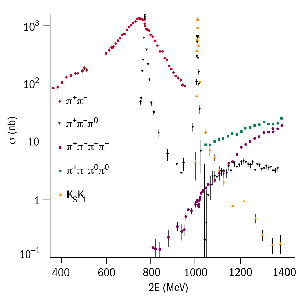
The VEPP-2M electronpositron collider, which has been running at the Budker Institute of Nuclear Physics, Novosibirsk since 1974, amassed more than 4 x 107 phi mesons before the start of the new Italian DAFNE phi factory. With a fairly high luminosity of 3 x 1030 cm-2/s at the phi meson (1.02 GeV), VEPP-2M’s flexible magnetic lattice allowed operation in the pion production threshold to 1.4 GeV collision range.
Two detectors were installed for a series of experiments that started in 1992: CMD-2 (cryogenic magnetic detector) a general purpose detector with a drift chamber inside a 1 ton superconducting solenoid, barrel caesium iodide, and endcap bismuth germanate electromagnetic calorimeters; and SND (spherical neutral detector) a non-magnetic detector with an almost complete angular coverage sodium iodide calorimeter.
These detectors have been successfully complementing each other in their quest for rare decay modes of the rho, omega and phi mesons as well as high-precision measurements of hadronic reaction rates.
Among numerous accurate measurements of various phi decay modes is the first observation of the electric dipole transition to f0(980)/photon (figure 1) and to a0(980)/photon. A high branching ratio of about 10-4 may indicate an exotic four-quark structure of these enigmatic scalar particles.
Another radiative phi decay, to eta/photon, observed by both detectors, is the missing link in a long chain of magnetic dipole transitions among the vector and pseudoscalar mesons, which consist of light quarks. Also of interest to theorists are doubly suppressed decays, to two charged pions, to an omega/neutral pion and to four charged pions.
In addition to the search for rare decay modes of the vector mesons, low-energy measurements of the total electronpositron annihilation cross-section R will allow the precise calculation of the hadronic vacuum polarization, which is currently a limiting factor in other precision analyses. The goal is to measure R to an accuracy greater than 1%.

The dominant contribution below 1 GeV comes from the simplest hadronic reaction, which produces charged pion pairs. Of more than 2 million pion pair events detected by CMD-2, about 150 000 have been analysed in the rho meson energy range (610-960 MeV). Thorough analysis of possible systematic effects allowed the final cross-section to be measured with a systematic uncertainty of only 0.6%.
Other achievements include the measurement of three- and four-pion production above the phi meson. The cross-section for annihilation into three pions (two charged) determined by SND agrees with the previous measurement, but it is more precise and shows peculiar behaviour that is consistent with the existence of the omega at 1200 MeV rather than 1420 MeV as recommended by previous interpretations. Analysis of this channel by CMD-2 is still in progress.
Both groups measured two possible final states of the four-pion production with consistent results. The elegant analysis at CMD-2 of intermediate mechanisms leading to the four-pion final state is also important. While for two charged and two neutral pions the omega/neutral pion and a1(1260)/pion channels contribute, it is the latter that saturates the final state with four charged pions.
High luminosity allows the measurement of much smaller cross-sections, at the level of 0.5 nb and below. This is important for the precise determination of R. Figure 2 gives a general impression of the energy dependence of the major contributing processes.
However, VEPP-2M is probably facing its last season. The Budker Institute recently proposed revamping the collider by implementing “round beams” as well as superconducting magnets to increase luminosity and energy. The design foresees flexible operation in the threshold to 2 GeV broad collision energy range, with a maximum luminosity of about 1032, which covers vector meson recurrences and gives a dominant contribution to the uncertainty of important hadronic corrections.
Construction of the new collider as well as the planned upgrade of both detectors should start in 2000, thus justifying the tentative name of the new machine VEPP-2000.





